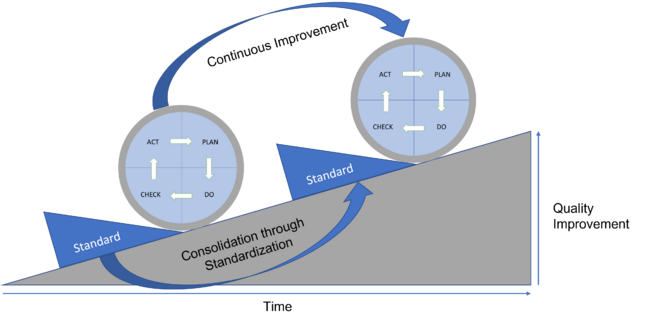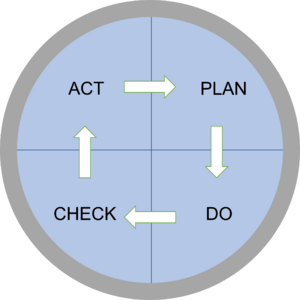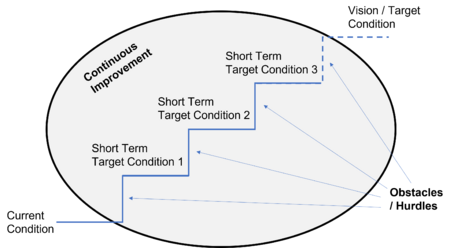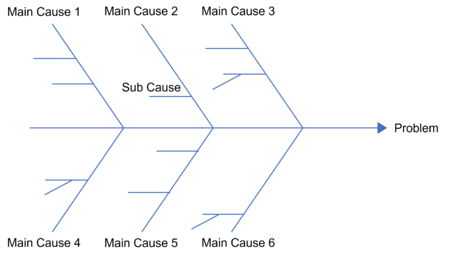Continuous Improvement / Kaizen
| Line 73: | Line 73: | ||
'''Ishikawa Diagram''' | '''Ishikawa Diagram''' | ||
| + | [[File:Ishikawa.png|right|450px]] | ||
A tool commonly used in connection with Continuous Improvement is the Ishikawa Diagram. The tool is also known as Root-Cause or Fishbone Diagram. The Ishikawa Diagram is a systemic approach to identify causes for a problem at hand. The main goal of the Ishikawa diagram is to reveal and break down the various causes that contribute to a problem. The identified causes are then addressed through mitigation measures. | A tool commonly used in connection with Continuous Improvement is the Ishikawa Diagram. The tool is also known as Root-Cause or Fishbone Diagram. The Ishikawa Diagram is a systemic approach to identify causes for a problem at hand. The main goal of the Ishikawa diagram is to reveal and break down the various causes that contribute to a problem. The identified causes are then addressed through mitigation measures. | ||
Figure 1 shows a typical model of the Ishikawa Diagram. A problem is usually written on the right side of the model which is then connected to potential main causes. The main causes build the “bones” of the model. For the main causes, the 5M (Material, Machine, Manpower, Method and Milieu) are often used as a starting point. Afterwards, sub causes are added to the main causes. Theses sub causes are represented by the horizontal lines attach to main causes. The causes are usually identified in brainstorming activities, conducted by multidisciplinary teams. The subdivision of causes is done, til the problem at hand has been understood completely [5]. The causes are then tested for validity until the desired effect has occurred. i.e., the problem has been solved. | Figure 1 shows a typical model of the Ishikawa Diagram. A problem is usually written on the right side of the model which is then connected to potential main causes. The main causes build the “bones” of the model. For the main causes, the 5M (Material, Machine, Manpower, Method and Milieu) are often used as a starting point. Afterwards, sub causes are added to the main causes. Theses sub causes are represented by the horizontal lines attach to main causes. The causes are usually identified in brainstorming activities, conducted by multidisciplinary teams. The subdivision of causes is done, til the problem at hand has been understood completely [5]. The causes are then tested for validity until the desired effect has occurred. i.e., the problem has been solved. | ||
| Line 80: | Line 81: | ||
The advantage of this systematic approach is that it is simple, easy to implement and can be used for most problems. However, there are some conditions that should be met for effective use of the tool. First, the problem at hand must be described in sufficient detail to allow conclusions to be drawn about causes. Second, questions must be answered truthfully. And last, it must be desired to analyze the problem down to the root cause and not to force symptom fighting in order to be able to achieve quick but not sustainable improvements. Identical to the Ishikawa Model, the 5 Why Method can be used individually, but works best when conducted by a multidisciplinary team [8]. | The advantage of this systematic approach is that it is simple, easy to implement and can be used for most problems. However, there are some conditions that should be met for effective use of the tool. First, the problem at hand must be described in sufficient detail to allow conclusions to be drawn about causes. Second, questions must be answered truthfully. And last, it must be desired to analyze the problem down to the root cause and not to force symptom fighting in order to be able to achieve quick but not sustainable improvements. Identical to the Ishikawa Model, the 5 Why Method can be used individually, but works best when conducted by a multidisciplinary team [8]. | ||
A practical application of the tool could look like the following: | A practical application of the tool could look like the following: | ||
| + | |||
1. Team development and problem description. | 1. Team development and problem description. | ||
| + | |||
2. Brainstorming in the Team for potential causes (answers the first why). | 2. Brainstorming in the Team for potential causes (answers the first why). | ||
| + | |||
3. Following the different answers/paths with further why questions. | 3. Following the different answers/paths with further why questions. | ||
| + | |||
4. Discussion of the different logical paths and search for systemic root causes. Team decision for the most probable cause. Showing the result to other uninvolved parties can ensure that the result has a comprehensible logic. | 4. Discussion of the different logical paths and search for systemic root causes. Team decision for the most probable cause. Showing the result to other uninvolved parties can ensure that the result has a comprehensible logic. | ||
| + | |||
5. Development and initiation of mitigation measures. The development should also take place as a team action [8]. | 5. Development and initiation of mitigation measures. The development should also take place as a team action [8]. | ||
| + | |||
Despite many advantages, there are also some shortcomings to the method. For example, if the problem is not broken down in enough detail, only symptoms are addressed instead of root causes. In particular, inexperienced users are susceptible to this error. Furthermore, the repeatability of the results is relatively low. Different teams often arrive at different results and therefore also at different corrective measures [8]. The tool is usually less of an indepth analysis in comparison with the ishikawa but can be used in combination with it. | Despite many advantages, there are also some shortcomings to the method. For example, if the problem is not broken down in enough detail, only symptoms are addressed instead of root causes. In particular, inexperienced users are susceptible to this error. Furthermore, the repeatability of the results is relatively low. Different teams often arrive at different results and therefore also at different corrective measures [8]. The tool is usually less of an indepth analysis in comparison with the ishikawa but can be used in combination with it. | ||
Revision as of 22:35, 19 March 2022
Contents |
Abstract
Continuous Improvement, also referred to as Kaizen, is a concept that is related to principles, methods and activities that have the target of continuously improving the performance of an organization or individual. Continuous Improvement focuses on incremental steps that eventually lead to big improvements over time, rather than breakthrough changes. The concept is best depicted by the phrase “a long journey begins with a small step”. In a wider and more cultural sense, the concept is based on the assumption that the world is steadily changing and can always be improved. The concept of Kaizen is Japanese and means kai = change, zen = to improve. Although there are slight definitional differences, continuous improvement and kaizen are fundamentally similar. Hence the two terms are generally used synonymously [1]. In an organizational context, Continuous improvement is a strategic and long-term effort to enhance competitiveness by improving quality, cost and time. The effort usually is directed at achieving certain objectives and is therefore different to the concept of idea management, that revolves around collecting, implementing and rewarding ideas of employees [2]. Improvement is achieved by applying an iterative process of constantly observing the current situation and implementing improvements. Improvements should then be standardized and disseminated to other areas. Furthermore, Continuous Improvement tries to involve employees from all hierarchy levels of an organization in the improvement process. Therefore, it is a popular concept in industry as it is easy and cheap to implement and not limited to any industry and organizational size [1]. The concept of Continuous Improvement is illustrated in figure 1.
Historical of Continuous Improvement
Continuous Improvement first appeared in Japan during the second world war. It was an answer to the numerous and serious damages that the country had suffered. The concept was used by authorities in order to reconstruct the country. Furthermore, the development of continuous improvement was supported by the use of the U.S. training program Training with Industry (TWI Inc.), which aimed at developing training programs for Japanese companies. The small-step approach was preferred, as resources were scarce and major change initiatives could not be afforded. Even though elements of continuous improvement such as suggestion systems or quality systems were regularly used in Japanese industry, the concept only got further attention with the development of the oil crisis in 1973. In a period of financial constraints, companies such as Toyota have used the concept to achieve cost reductions with little expenditure of resources. Parallel the company Canon was able to gain large benefits of up to 200 million US Dollar by launching a continuous improvement campaign. As the profits did not go unnoticed, continuous improvement made its way into the western economy in the 1980s. Remarkable benefits could be achieved by companies such as Xerox, Motorola, Harley Davidson, and General Electrics [1].
Continuous Improvement in Relation to Project, Program and Portfolio Management
Continuous Improvement was originally created to improve production processes and is today commonly used in that area. And even though Continuous Improvement focuses on the constant challenge to improve standards [1], it is applicable in any organizational area including project, program and portfolio management. Although projects are always unique to some degree, different projects in an organization often involve recurring activities, methods and processes that can be constantly improved. Furthermore, projects can be embedded in organizational processes that structure the frame within projects are being carried out. Continuous Improvement needs to be seen as a learning effect that is achieved project by project and can be transferred into the organizational knowledge base. The project management standard ISO21500 recommends that Continuous Improvement, as one of several underlying concepts, should influence thinking and behavior in the governance and management of projects. Furthermore, knowledge gained must be documented and shared throughout the organization, also to increase performance in future projects [4].
Key Concept and Benefits
The idea of Continuous Improvement is part of the bigger concept of Lean Management, which has its origins in the Toyota production System. The term Lean is described by Krafcik (1988) as a (manufacturing) process that uses less of everything in comparison with mass production including human effort, space, tool investment and engineering to develop a new product in less time. Another definition is done by Krajewski, who describes lean systems as systems that maximize the added value of each activity in an organization, by eliminating waste and delays. Continuous Improvement is thus aiming at incrementally improving organizational activities by using less of everything or reducing waste and delays.
A key idea of Continuous Improvement can be found in the PDCA Cycle, that was designed by William Edwards Deming in the 1930s. The Cycle describes an iterative process of continuous learning. It consists of the four Phases Plan, Do, Check, Act.
Plan: The planning phase consists of the two major steps observation of the situation and proposing a hypothesis why the targeted situation can not be reached. Here, causes that prevent the desired situation from being reached need to be identified, e. g. with a Ishikawa Diagram or 5-Why Analysis. The first step also focuses on clarifying the desired future situation besides observing the current state.
Do: The Do phase revolves around the development and testing of countermeasures for the identified root causes.
Check: In this phase the data obtained by performing the countermeasure is analyzed. The result of this analysis should be the acceptance or rejection of the hypothesis. Gained insights should be documented.
Act: This step contains the actual implementation of the countermeasure. Countermeasures should now be standardized and monitored. A reflection about leasons learned is recommended. If the hypothesis test failed, a new one needs to be proposed [7].
The successful implementation of Continuous Improvement provides numerous benefits. Some benefits are named in the following listing:
- Quality Improvements: Quality issues are a focus of Continuous Improvement. Deviations in quality are analyzed in detail to prevent errors from recurring.
- Increased Productivity/Less Waste: Continuous Improvement fosters the efficient use of available resources, resulting in less need of resources for a given output.
- Employee skills improve: Continuous Improvement is not only aimed at improving standards and processes, but also human resources. Especially, since Continuous Improvement seeks to involve employees in various activities, they are continuously educated. Raising awareness of potential improvements, making employees understand their work better.
- Fostering a holistic view: Problems are often tackled in interdisciplinary work groups, thus assuring that different perspectives and interests are met.
- Customer Satisfaction increases: Improvement can be translated into customer satisfaction. For instance, quality improvement, end of project is reached faster, cost reduction.
- Higher motivation of employees/Increased participation: Through Continuous Improvement employees have the chance to actively contribute to organizational improvement. Seeing their ideas having an impact, can be factor for employee motivation. Furthermore, Continuous Improvement involves all employees meaning that combined organizational knowledge can be used.
- Increased employee self-esteem: Continuous Improvement can create a learning environment for all employees. As professional self-esteem depends on knowledge and experience, it grows as improvements continue over time.
- Higher Responsibility of employees: As problems are solved in multidisciplinary teams, all participating employees (from all hierarchy levels) are responsible for a certain task.
Implementation and Requirements
Continuous Improvement can be implemented in an organization in different ways and to different extends. Whether the concept is implemented within a large campaign or in a more slow and organic manner depends on the needs and capabilities of each individual organization. It is important however, that the introduction of Continuous Improvement is not seen as a project, but as an ongoing process. The following chapter will present recommendations on how to implement Continuous Improvements as well as considerations that should be taken into account for both the preparation or implementation and actual execution phase.
Describing a clear target condition: A first fundamental step in implementing continuous improvement is to define a target condition that describes a desired future situation. Describing a vision assures that all improvement efforts are clearly directed towards it. Change is only considered improvement when it is directed towards a common goal. The target conditions functions as guide for all involved people. The target condition should be medium to long term, but can be supplemented by short term goals. By eliminating causes of hurdles on the way towards the vision, improvement is achieved step by step [6]. The target condition is often already included in a companies vision or strategy.
Securing Management Commitment: Continuous Improvement is a long-term effort that provides numerous benefits, but also requires the use resources. Furthermore, management is responsible for developing a culture, that fosters employee participation and therefore boost change and improvement. A Management that does not try to implement solutions directly or generally does not fully support the initiatives, risks that the actions fizzle out due to demotivation. Management should also empower internal working groups to implement their ideas [1].
Human Resources Training: With potentially all employees being included in continuous improvement, a certain knowledge level is required to effectively apply the concept. The level of knowledge depends on the different roles in the organization, however basic in problem solving methods (Fishbone, 5-Why, Pareto Analysis) are recommended [1].
Problem Detection: The Process of Continuous Improvement starts with the detection of problems. Workshops or Circles, such as a Kaizen Event (XXXXXXXXXX verlinken XXXXXXXXXX) are a suitable tool to examine processes and workflows with regard to weaknesses in the team. Another possibility is to address problems in regular (e.g. daily morning meeting) [2].
Problem Solving in Interdisciplinary Teams: To benefit from the different capabilities and expertise, multidisciplinary teams should be used as much as possible in the problem-solving process. The solution generation can also be examined within the initial workshop. Within this process, problem solving techniques such as 5-Why or Ishikawa should be used (See Chapter Tools and Methods in Continuous Improvements) [1]. By evaluating and prioritizing solutions in terms of suitability, a clear plan of measures is created. The implementation of measures works accordingly to the PDCA Cycle. The Team needs to be kept updated about the successful implementation improvement measures. Furthermore, the team needs to be acknowledged for their achievements [1].
...
Tools and Methods
Within the Concept of Continuous Improvement, several Tools can be used within the process. The are used for different purposes such as idea generation and problem analysis. The following chapter will introduce three of the most commonly used tools as well as list of further helpful tools.
Ishikawa Diagram
A tool commonly used in connection with Continuous Improvement is the Ishikawa Diagram. The tool is also known as Root-Cause or Fishbone Diagram. The Ishikawa Diagram is a systemic approach to identify causes for a problem at hand. The main goal of the Ishikawa diagram is to reveal and break down the various causes that contribute to a problem. The identified causes are then addressed through mitigation measures. Figure 1 shows a typical model of the Ishikawa Diagram. A problem is usually written on the right side of the model which is then connected to potential main causes. The main causes build the “bones” of the model. For the main causes, the 5M (Material, Machine, Manpower, Method and Milieu) are often used as a starting point. Afterwards, sub causes are added to the main causes. Theses sub causes are represented by the horizontal lines attach to main causes. The causes are usually identified in brainstorming activities, conducted by multidisciplinary teams. The subdivision of causes is done, til the problem at hand has been understood completely [5]. The causes are then tested for validity until the desired effect has occurred. i.e., the problem has been solved.
5-Why Another tool that is used in Continuous Improvement is the 5-Why. The tool tries to tackle the same issue as the Ishikawa Diagram, identifying the root cause of a problem, so that it does not occur again. The tool is applied by looking at a symptom (problem) and asking why it happened. The answer to why is then questioned 5 times. The process can usually be terminated if the why questions do not yield any new insights. Similarly, the why question can be asked more than five times [8]. The principle is illustrated as an example in Figure XXX. The advantage of this systematic approach is that it is simple, easy to implement and can be used for most problems. However, there are some conditions that should be met for effective use of the tool. First, the problem at hand must be described in sufficient detail to allow conclusions to be drawn about causes. Second, questions must be answered truthfully. And last, it must be desired to analyze the problem down to the root cause and not to force symptom fighting in order to be able to achieve quick but not sustainable improvements. Identical to the Ishikawa Model, the 5 Why Method can be used individually, but works best when conducted by a multidisciplinary team [8]. A practical application of the tool could look like the following:
1. Team development and problem description.
2. Brainstorming in the Team for potential causes (answers the first why).
3. Following the different answers/paths with further why questions.
4. Discussion of the different logical paths and search for systemic root causes. Team decision for the most probable cause. Showing the result to other uninvolved parties can ensure that the result has a comprehensible logic.
5. Development and initiation of mitigation measures. The development should also take place as a team action [8].
Despite many advantages, there are also some shortcomings to the method. For example, if the problem is not broken down in enough detail, only symptoms are addressed instead of root causes. In particular, inexperienced users are susceptible to this error. Furthermore, the repeatability of the results is relatively low. Different teams often arrive at different results and therefore also at different corrective measures [8]. The tool is usually less of an indepth analysis in comparison with the ishikawa but can be used in combination with it.
Limitations
What is necessary in an organization to achieve continuous improvement
Where are the obstacles
Commitment of management
Failure culture
Bibliography
Trabasso, L. G., & Pessoa, M. V. (2016). Continuous Improvement. In Lean Product Design and Development Journey (S. 89-104). Springer International Publishing.
Muralidharan, K. (2015). Continuous Improvement. In Six Sigma for Organizational Excellence (pp. 517-532). Springer India.



